Search: Tackle Support Down Channel
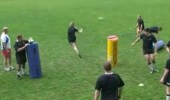 0:26
0:26
Tackle bag drill 3 man support after tackle
This is a very effective drill for developing decision making and awareness in support runners off a tackle situation
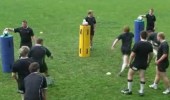 0:25
0:25
Tackle bag drill one hit & support
support has to read whch bag is being tackled and get to be in support by reading the situation
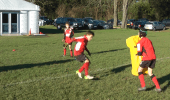 1:04
1:04
Tackle Technique in channel
Use a channel with attackers and defenders to progress the tackle technique, mix the players up so they all have opportunities. Reinforce the coaching points and give praise regularly
To watch over 2500+ videos join now for free!
JOIN NOW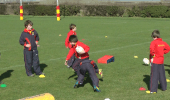 2:24
2:24
1 v 1 Tackling in Channel
An opportunity for players to put what they have learnt on tackle technique into practice. Each tackle is observed by all other players who can give feedback. Ensure all players have a go at attacking and defending.
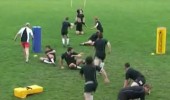 0:11
0:11
Offload out of the tackle in channel
A good start for developing offload and tackle skills, allowing you to manage the amount of contact in the tackle whilst performing the skill successfully. Key factors : Strong base - Lead with arm and shoulder - Keep looking forward with head up - Wrap arm around legs / waist and squeeze tight with other arm - Use attackers bodyweight to rotate your body
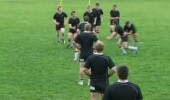 0:10
0:10
Offload out of the tackle in channel 2
A good progression for developing difficulty from a standard drill, look at carrying the ball and moving the defender so that you can ride the tackle
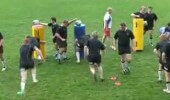 0:25
0:25
Tackle bag drill in 4s with support
A progression for developing support after contact
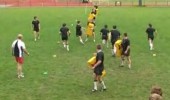 0:12
0:12
Draw the defender and support in channel
The key to creating space is to move a defender away from the space, this drill allows the ball carrier to create the space and the support runner to attack the space
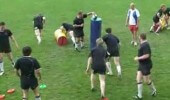 0:14
0:14
Tackle bag & support hi intensity drill
Sometimes a high intensity, high repitition drill is very effective at getting the point home
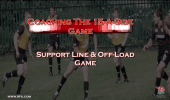 2:46
2:46
L2 - Support Line Breaks & Offloads
Skill Practice Description • The game begins with touch tackles. • Once tackled the ball carrier is allowed to step beyond the tackle line and the support from either side run toward (or attack) the ball. • The pass must be delivered behind the tackle line and not put back in front of the defence, so speed and decision making is vitally important. • Develop the game to grip tackles below the rib cage so the ball can be off loaded. • Progress to full tackles and the ball carrier must fight to keep the ball available. • The support must be aggressive in attacking the ball and getting between and beyond defenders. • When in full contact and the ball carrier cannot off load immediately, rucks and mauls may be played. Key Coaching Points • The game relies on good support play in all areas. This game illustrates the need for consistent and aggressive support. • The supporting players need to work for the ball carrier and attack the ball, getting in behind the defence for an off load. • Once the tackle line has been breached the attack must not allow the defence time to reorganise. • When progressed to full contact, the demand on decision making increases
L2 - Diamond Support Development
Skill Practice Description • Play a game of touch or grip tackle. • At the coach’s discretion, call “slow ball!” or “freeze” and allow the attack to form a diamond behind the 1st or 2nd receiver. Then call “Play!” • The defence will also be organised but this will be the case in a full game. • Allow the game to progress and shorten the time they have at the slow ball scenarios. • Don’t be concerned if there are not four players in the formation as long as there is at least a second tier of support. • As players become competent at forming the shape in front of the tackle line, the coach may develop the ability to form again, having made a line break. • Develop the game into full contact. Key Coaching Points • Holding spaces open. • Ball carrier to watch the defensive shape and not look round for the support. • Listening and cooperation. Play with the eyes in front and the ears behind. • Intuitive decision making. • Support to hold depth and not arrive at the tackle line flat.
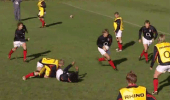 0:22
0:22
Diamond shape support
An exercise for continuity and support.
The coach can set the width of the channel and intensity of the defenders
L2 - Penetrating Defence Game
Skill Practice Description • The playing area is marked out in 5m channels. • When defending, players must stay within their channel throughout the game. • The attack must look to penetrate the defence by creating and preserving space. • The defence must use a two handed touch. • There is a 5 tackle turnover rule and once possession is turned over, the defence must get into a channel as the opposition can attack immediately. Key Coaching Points • Support players to hold their opposite number as long as possible before cutting a line to take the pass. • The defender can close the space as far as the edge of their own channel. • If the support player cuts too early or the ball carrier does not move their defender enough, the support player will be touched/tackled. Relevance to the Game • This game will help develop the footwork and running lines to effectively move defenders in order to penetrate the tackle line.
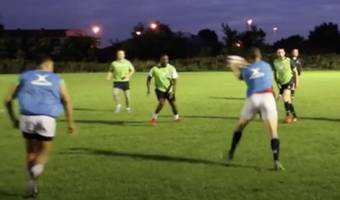 3:39
3:39
Two Touch With Tackle Practice
This game has multiple conditions for both attackers and defenders. Dropping defenders to practise their tackling while working on support lines and groundwork for the attackers. Great for the first half an hour of your session
L2 - Support Line Breaks
Skill Practice Description • The objective is to increase the commitment to supporting a line break. • The teams play continuous touch, grip or tackle. • Stage 1: when a score is made all attacking players must touch the try line within 3 seconds or the try is disallowed and a turn over is awarded. • Stage 2: when a try is scored all attacking players must touch the ball on the ground within 5 seconds or the try is disallowed and a turnover is awarded. • Play starts again direct from the try line. • The coach may split the defence so cover defenders can challenge the effect of support play once the first line has been breached. Key Coaching Points • Encourage supporting players to angle toward the line break and not stay wide and lateral. • Encourage all attacking players to react and support a line break. • Speed of reaction. • Communication and team work
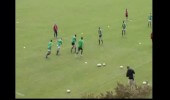 0:48
0:48
Lions - Attacking channells
From the Lions 2009 tour, a support drill in a channel to encourage the ball carrier to move the defender and make space for the support player
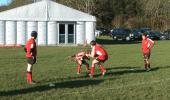 1:26
1:26
Live tacking in channel
Finally introduce live 1 v 1 tackling in a controlled environment using a channel. Standards will vary but as coaches it is important to praise all of the players. Doing this exercise too early may cause problems and refrain from doing so until the fundamental skills have mastered
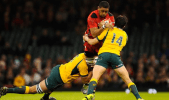 3:44
3:44
Tackling Aussie Style
Australian coaches across all age groups have a slightly different approach to teaching the tackle, or do they? You can take a few of their tips and integrate them into your coaching process
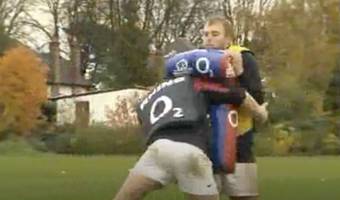 4:23
4:23
Impact Wrap Tackle
Impact Wrap Tackle
 5:15
5:15
Coaching tackle technique in groups
The ability to move from 1 to 1 tackling exercises into unit & group skills can be tricky. Here are some tips that you could use
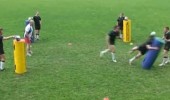 0:35
0:35
Tackle bag grid chase the tackler 2
a high intensity support and conditioning drill in a small space, that you can manage
 1:32
1:32
Quins Defence - 1 v 1 tackle skills
Close contact in a small channel ensures the players work their movement skills in both attack and defence. The coach reinforces the skills for contact prior to progressing this exercise
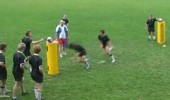 0:04
0:04
Tackle bag grid chase the tackler
A very effective support and conditioning exercise, you can change the space and pace and duration of the work effort
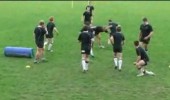 0:27
0:27
One handed offload out of the tackle
Develop a players ability to make an effective pass under pressure with support players trailing
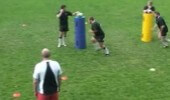
Tackle bag chase the tackler
This will act as a conditioning and as a support drill, working both players hard
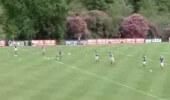 0:23
0:23
British lions - support & attack drill 1
This drill illustrates how attack can go from narrow channels to wide play very quickly, and players should practice this continually
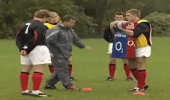 12:52
12:52
Tackle Technique - Progressions for Juniors
This clip illustrates tackle technique using progressions suitable to all players and possibly requiring regular revisit to embed safe and effective tackling
 1:10
1:10
Using Games to Develop Passing and Support
Using games to coach is how most Premiership coaches improve skills and especially decision making. In this clip Jon Curry uses some clever rules to encourage supporting lines to help keep the ball alive
Impact Guard Tackle
This tackle is used when close to either try line and intended to stop the ball carrier from moving forward
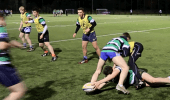 5:13
5:13
Improving support play
Decision making is a tricky skill to coach. Danny Wild the Leeds coach uses conditioned games with breakout technical sessions to improve this process as well as working on some groundwork skills
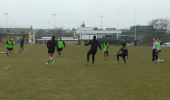 2:59
2:59
Quins Defence - Tackling in units 3 v 3
This exercise is part of a tackle technique progression and pitches 3 attackers v 3 defenders. As in match play the attacking players will present different challenges to the defenders. The coaches can choose to alter the conditions to put more or less pressure on the players
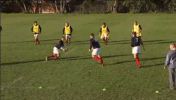 0:39
0:39
Supporting lines - Trail running
A game to challenge how players support with lines of running and communication
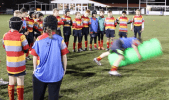 5:51
5:51
Tackling - When is the tackle completed?
It is very much an individual choice as to when a tackle is completed to when the defender can compete for the ball. What is generally accepted is that good tackle technique will enable the defender to "Be ready" for his next task. This clip explores why a strong grip or "Ring of steel" will enable the tackler to be dominant
 5:07
5:07
Tackle Technique - Full Session
[WITH DRILL VIDEOS] This session from Joe Goodman (Bristol University Rugby) has been designed to prepare players for a return to full contact competition, re-establishing correct technique to ensure safe, efficient tackling through progressively increasing the level of contact and complexity of skill execution.
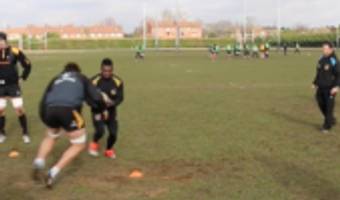 2:18
2:18
Tackling 20 - 2-man Tackle
Tackling 20 - 2 man Tackle
Tackling 3 - Hunting a Tackle
Tackling - Hunting a tackle
Tackling 11 - Rear Tackle
Tackling - Rear Tackle
 4:29
4:29
Kiwi Tackling - Coaching Dominant Tackling
To be a dominant tackler you need to practise the core skills regularly. The tackle has many factors to it and here are some tips from New Zealand
 5:28
5:28
Kiwi Tackling - Pre Tackle Practises
Sharing our coaching ideas is great for the game. Players in New Zealand hone their skills at an early age and it is globally accepted that they have the best techniques across all positions. Coaching the tackle is a key fundamental that all players practise regularly
Support
Tackling 10 - Side-on Tackle
2-man Tackle and Decision-making
This practice develops communication in a three v three game format
Tom Wood on Tackle Technique
Tackling 9 - Revise Tracking and Front Tackling
 3:21
3:21
Three Channel Passing Challenge
Adding pressure to key skills is crucial to improve your players and to practise like you play. This exercise covers a variety of skills but essentially is about accurate passing and fixing defenders
Back Row Attack Support
Back Row Attack Support
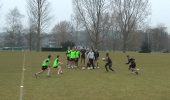 2:59
2:59
Quins Defence - 2 v 2 tackling
A progression from the 1 v 1 drill this exercise adds extra players to make the decision making process more realistic. The coaches can vary the delivery of the ball and the width of the area to put different conditions to the players
 7:19
7:19
Sevens - Uncovered - The Support Staff
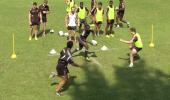 6:17
6:17
Quins - Attacking lines of support
Harlequins academy players are coached to be accurate in their passing and use lines of running and footwork to create space for other players
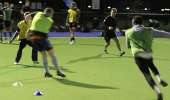 2:40
2:40
Two Channel Passing Exercise
Players work in 3s running around the corner and realigning to attack. Introduce defenders and the need to look up and communicate.
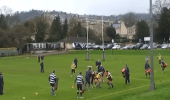 1:03
1:03
Offloads through contact then lateral pass
In groups of 4, players must support each other through a tight channel of tackle shields, before panning out to complete lateral passes to the wing.
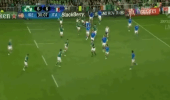 0:18
0:18
Men's - Turnover and move the ball 2
Strong defence and a turnover allows two quick passes, (One long pass), and then attack the defence. The two passes have changed the channel of attack by 30 metres.
Key factors : Tackle and stay on your feet - Long quick pass / spin pass - Communicate loudly - Support the ball carrier on his shoulder
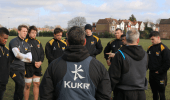 4:03
4:03
Wasps - Footwork The Key To Big Tackles
Aggressive tackling is fundamental to Wasps performances and their players physicality is part of their DNA. Brad Davis overseas a tackle technique session that will change your approach to coaching the tackle
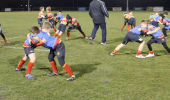 6:32
6:32
Tackling - Hook & Grip For Safety
The "Hook & Grip" element in the tackle creates strong & effective contact with your opponent which enables accurate tackling. A strong grip (Ring of Steel), is the precursor to a dominant tackle and this skill is crucial for all players. The practises in this video are excellent for players who may lack confidence or where you have a variety of competence among your squad
Passive Front Tackle
The passive front tackle
This tackle is necessary when the defender is not in a position to make a strong aggressive tackle and uses the momentum of the attacker to bring them to the ground
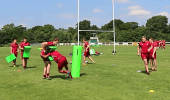 2:27
2:27
Reaction Tackle
Keep your players on their toes with this quick-fire 1v1 tackling exercise. Start with bags then progress to live tackles. Defending players have an obstacle to negotiate before performing the tackle, just as they may have in a game.
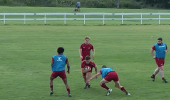 4:34
4:34
Game - Tackle Touch
Whether you're introducing tackling to young players for the first time, or re-introducing it to senior players after a summer away, this is a great game to play to ease back into it. It isolates the 1v1 tackle and puts emphasis on technique without the high speed impact of a full contact game.
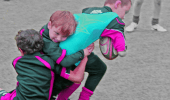 5:24
5:24
Develop Confidence For Tackling
Developing confidence in and around the tackle is very important when starting to teach tackle techniques. This clip provides a few ideas that you could use in your sessions
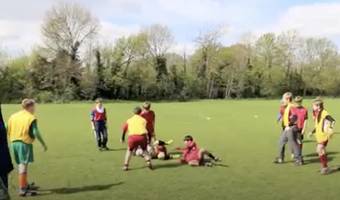 3:56
3:56
Tackling games for juniors
Tackling and contact are key components in the development of young players, this clip shows how coaches can introduce tackling using a game that reduces the risk of injury and focuses on the technical skills
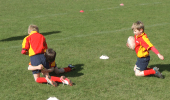 1:51
1:51
Tackle on Knees
An easy progression into tackling, with some movement. Use to build players' confidence before moving into full tackling.
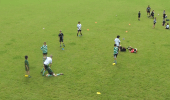 1:45
1:45
Tackle Technique in groups
Give players the opportunity to practice their tackling technique. In groups of five, one player in the middle has four tackle attempts. Make sure everyone has a go and the key points are repeated.
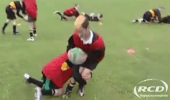 1:20
1:20
Introduction to tackling - Step 2
The transition from practicing tackling on knees to tackling on feet starts with the tackler remaining on their knees and the ball-carrier walking past. Then progress to having both players on their feet, but still executing the tackle at a controlled, walking pace.
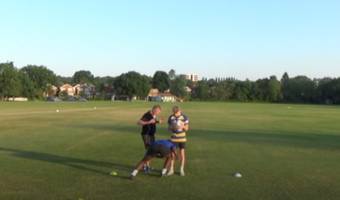 1:45
1:45
Around The Clock Tackling
Set up 5 cones around in a circle. The tackler works out from the first cone to make the tackle. The tackler then backtracks around the next and then comes forward to make the tackle again. Two tackles off the right shoulder, one front on and two off the left shoulder.
Offensive Front Tackle
The offensive front tackle
This practice shows front tackle technique when the defender is in a strong and balanced position
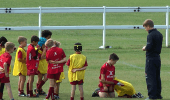 7:59
7:59
Learning to Tackle - Under 9's & Up
The RFU new rules of play have completely changed the approach of introducing young players to tackling. A phased approach may challenge previous methods however by viewing the practical session on this video you can see how the process works
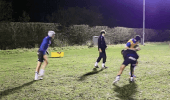 3:48
3:48
Junior Tackle and Breakdown
Good tackle technique leads into being effective at the breakdown, this clip provides advice on how to coach the tackle combined with the next phase of getting to your feet and competing for the space or ball
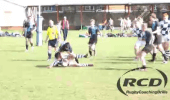 1:00
1:00
Support - Turnover and Counter-Attack
Support play is essential to rugby, particularly in sevens where there is more space. This clip sums up the importance of support. The Eastbourne College scrum-half is isolated and turned-over. Eton then counter-attack and, despite the best efforts of a single Eastbourne defender, they are able to secure the try thanks to an offload to a support runner.
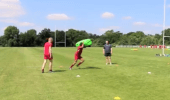 4:17
4:17
Technical Fitness with Tackle Bags
Tackle bags are a great tool to use in your conditioning sessions. The reduced impact allows players to peform high repititions of contact technique under fatigue, with low risk of injury.
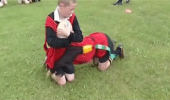 5:54
5:54
Defence - Tackle Progressions
Understanding tackle techniques and the progressions is integral for all coaches as a basic fundamental in coaching contact. The IRB "rugby ready" course provides a step by step approach to compliment the technques in this section
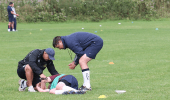 3:51
3:51
Player Welfare and Tackle Technique
Head injuries are a serious consequence to rugby and an area that deserves the attention of all players and coaches. Be proactive by coaching and re-coaching tackle technique to reinforce good habits.
 5:13
5:13
How to coach the Catch or Choke Tackle
Some of the latest ideas around tackle technique and what defenders are trying to achieve. This session provides the technical progressions needed to teach the choke / catch tackle
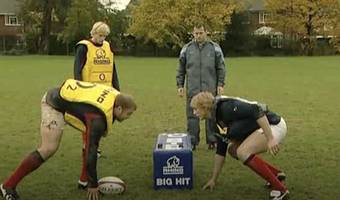 1:45
1:45
Passive Guard Tackle
This tackle is necessary when the defender is not in a position to make a strong aggressive tackle and uses the momentum of the attacker to bring them to the ground
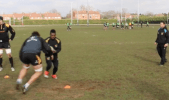 4:10
4:10
Wasps Tackle Safely & Dominate
Coaching a safe head position for tackling is not only a "Duty of care" for coaches but it also developes great body position and the platform to drive your opponents backwards. This video shows how physical the Wasps players are but not without safety & accurate technique
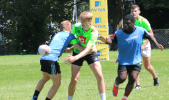 3:10
3:10
QBE - Support Line Breaks & Offloads
Support Line Breaks & Offloads
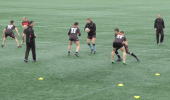 5:57
5:57
Games & drills for tackle technique
The Falcons coaches use a variety of games and breakout drills to progress their tackle technique session. The players respond to questions to vary the style of coaching
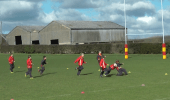 2:28
2:28
Tackling Game
A full-contact game with uncontested breakdowns, conditioned to have one team attacking for an extended time. The focus is on the defenders, who each have two tennis balls, to concentrate on their tackle technique.
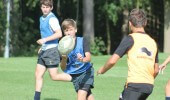 4:08
4:08
Using Games to Improve Support Play
Great tries are often the result of great support play. Coaches are now using more games in their training with set constraints put in to dictate what the coach wants to work on
 1:24
1:24
Tackle Technique Summary
Basic tackle technique is essential to rugby players of all ages and standards.
Tackle technique 5
Tackle technique 5
 6:05
6:05
Tackle Technique & Progressions
Introducing tackle technique to players is a challenging process and the Wasps coaches ensure the players understand and are competent at each step prior to progressing to the next one
 1:59
1:59
Chopping Feet To Coach Safer Tackling
Use equipment or players to force players to take smaller steps prior to the tackle, as attackers get better at late movement defenders need to practise in more demanding positions
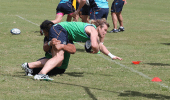 3:21
3:21
NSW Waratahs Tackle Technique
Some insight into how the NSW coaches approach coaching the tackle. This clip provides some tips on "How to coach" and some practical examples
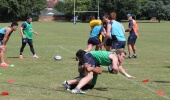 1:57
1:57
Tackle Technique Tips
Defence is a crucial part of the game, and it all starts with a solid tackle technique. Here's an introduction into a typical defence session, with some basic progressions focusing on body position and linespeed. Log in to see the full session.
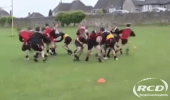 0:50
0:50
Introduction to tackling - Step 4
Jailbreak is a fun game that allows young players to become familiar with live tackling, as well as evasion. The game is played in a small area, to the increase the chance of tackles being made, and reduce the speed of the ball-carriers.
Tackle technique
Learning Tackle Technique
Tackling 4 - Feet and Body Position
Tackling 4 - Feet and Body Position
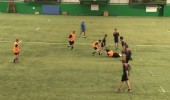 1:52
1:52
Tackle games - 5v5 Semi-contact
The sides are now even and the players can tackle, but not attempt to steal the ball. Again, the defence must retreat 5m, giving the attackers opportunities.
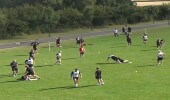 0:46
0:46
Tackle Technique Warm-up
Tackle Technique Warm-up
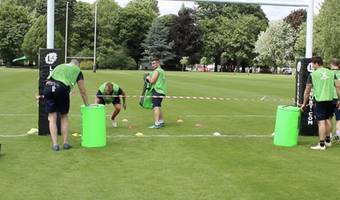 1:20
1:20
Developing Low Tackle Technique
Here is a new drill from London Scottish that encourages players to stay low in the approach and throughout the tackle
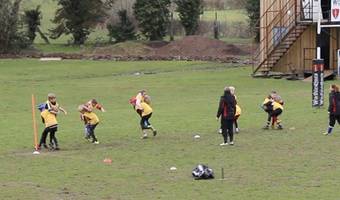 3:54
3:54
Intro To Safe Tackling
In this video we take a look at how these coaches introduce young players to safe tackle technique.
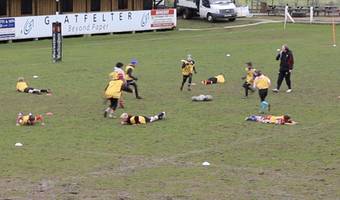 3:11
3:11
Fun Tackling Games
Try these fun games for any junior team. They are a great way to introduce tackle safety whilst keeping your players entertained.
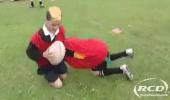 1:45
1:45
Introduction to tackling - Step 1
To build confidence in tackling technique and taking contact, it can be a good idea to start with players on their knees.
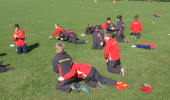 0:51
0:51
Tackle Technique - Introduction
The introduction of tackling is regarding by many coaches as the biggest challenge for volunteer coaches. This clips provides a summary of the main points
 3:33
3:33
Quins - Choke Tackle Technique
Harlequins coaches and players discuss the choke tackle, as well as the importance of enjoyment at training, and differences between players
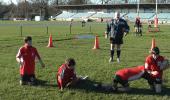 0:37
0:37
Tackling on Knees - 3 v 1
Using three attackers ensures the defender tackles on both sides and from slightly different angles. The coach can vary the pace and width of this exercise
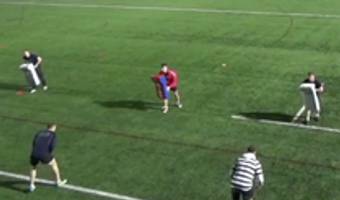 1:02
1:02
Chop Tackle - Pad Drill
Aim to develop good tackle habits through repetitive practice. Using pads allows you to train with intensity whilst lowering the impact on the body.
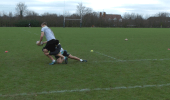 0:57
0:57
Coaching the leg Tackle
An example of a basic 1v1 exercise to practice the leg tackle.
 3:48
3:48
Tackle - Coaching safe head position
Coaching the correct head position for tackling is one of the most important skills for a coach, this clip shows a few examples that can be used with progressions
Tackle technique
Learning the tackle technique
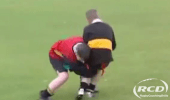 1:30
1:30
Learning to tackle - Step 5
Putting more pressure on players to take responsibility and make a tackle, 1v1 drills are challenging for young players, but also very beneficial.

